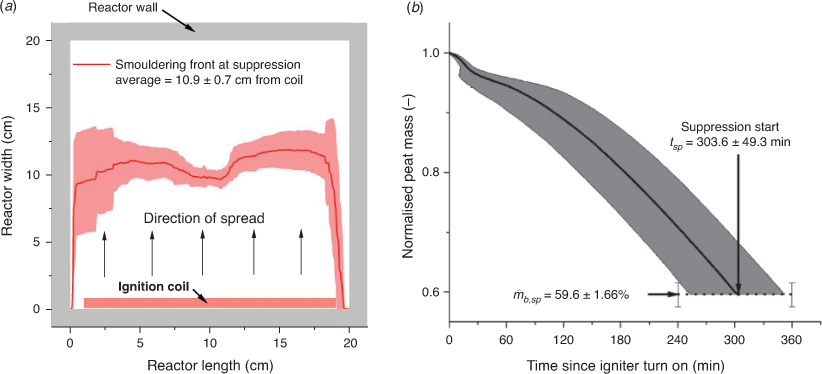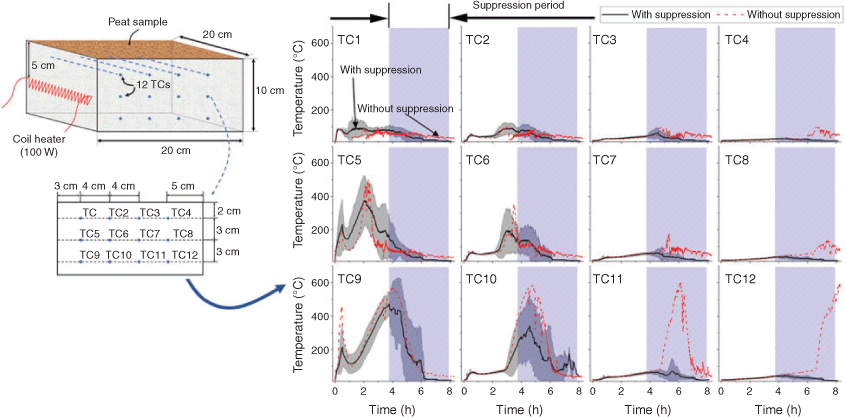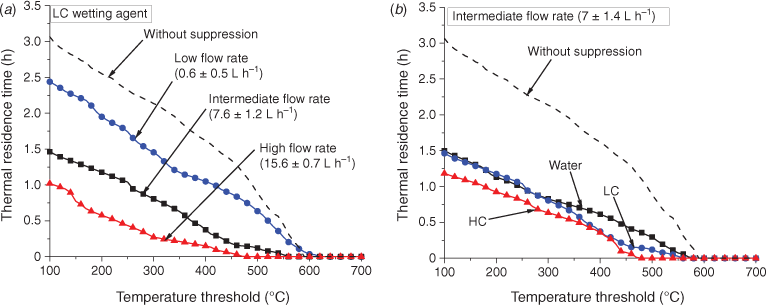Laboratory study on the suppression of smouldering peat wildfires: effects of flow rate and wetting agent
Muhammad A. Santoso A , Wuquan Cui
A , Wuquan Cui  A , Hafiz M. F. Amin
A , Hafiz M. F. Amin  A , Eirik G. Christensen
A , Eirik G. Christensen  A , Yulianto S. Nugroho
A , Yulianto S. Nugroho  B and Guillermo Rein
B and Guillermo Rein  A C
A C
A Department of Mechanical Engineering and Leverhulme Centre for Wildfires, Environment and Society, Imperial College London, London, SW7 2AZ, UK.
B Department of Mechanical Engineering, Universitas Indonesia, 16424, West Java, Indonesia.
C Corresponding author. Email: g.rein@imperial.ac.uk
International Journal of Wildland Fire 30(5) 378-390 https://doi.org/10.1071/WF20117
Submitted: 28 July 2020 Accepted: 4 February 2021 Published: 9 March 2021
Journal Compilation © IAWF 2021 Open Access CC BY
Abstract
The application of water, or water mixed with suppressants, to combat wildfires is one of the most common firefighting methods but is rarely studied for smouldering peat wildfire, which is the largest type of fire worldwide in term of fuel consumption. We performed experiments by spraying suppressant to the top of a burning peat sample inside a reactor. A plant-based wetting agent suppressant was mixed with water at three concentrations: 0% (pure water), 1% (low concentration), and 5% (high concentration), and delivered with varying flowrates. The results showed that suppression time decreased non-linearly with flow rate. The average suppression time for the low-concentration solution was 39% lower than with just water, while the high-concentration solution reduced suppression time by 26%. The volume of fluid that contributes to the suppression of peat in our experiments is fairly constant at 5.7 ± 2.1 L kg−1 peat despite changes in flow rate and suppressant concentration. This constant volume suggests that suppression time is the duration needed to flood the peat layer and that the suppressant acts thermally and not chemically. The results provide a better understanding of the suppression mechanism of peat fires and can improve firefighting and mitigation strategies.
Keywords: experiment, fire, firefighting, mitigation, peatland, smouldering, suppression, wetting.
Introduction
Wildfires can be driven by two types of combustion, i.e. flaming or smouldering (Rein 2013). A flaming wildfire is the result of homogeneous reactions between oxygen and gaseous pyrolysates such as the burning of some of the ground covering vegetation, while smouldering wildfire is the heterogeneous reaction between oxygen and solid char, such as the burning of peat (Rein 2016). Flaming wildfires are characterised by rapid spread rates (600 cm h−1), high temperatures (~1200°C) and a visible flame sheet, and smouldering wildfires are characterised by a slow (~6 cm h−1), low-temperature (~500°C), flameless form of combustion (Ohlemiller 1985; Rein 2016). In general, smouldering wildfires seem to be changing in terms of frequency, size and hazard in some parts of the world (Page et al. 2002; Turetsky et al. 2015; Walker et al. 2019). In term of emissions, smouldering is more hazardous than flaming (Hu et al. 2018). Smouldering peat releases a large amount of ancient carbon that has not been involved in the global carbon cycle for centuries (Walker et al. 2019) and therefore contributes to climate change, leading to a further increase of frequency and size of smouldering wildfires (Rein 2013). Large-scale peatland fires are subject to suppression efforts but typically only stop when the rainy season arrives, e.g. peatland fires in Southeast Asia in 1997 and 2015 (Page et al. 2002; Huijnen et al. 2016), illustrating the persistency of smouldering and difficulty in suppressing such fires (Rein 2013; Ramadhan et al. 2017; Lin et al. 2020). In pristine conditions, peatlands are naturally protected from burning because of their high moisture content, which can be up to 300% of dry basis mass in flooded condition (Moreno et al. 2011; Turetsky et al. 2015). Because of climate change and human activities, peatlands are drying in many places, which increases the susceptibility of peatlands to fire (Page et al. 2002; Turetsky et al. 2015).
Flaming wildfires are more common worldwide, spread faster (Ohlemiller 1985; Rein 2016) and cause more direct harm to lives and properties (McCaffrey and Rhodes 2009; Gibbons et al. 2012) compared with smouldering wildfires. Hence, most firefighting techniques are developed for flaming wildfires. The same techniques are also employed to fight smouldering wildfires, under the incorrect assumption that both fire types are similar. Techniques commonly used to suppress flaming wildfires include aerial attack by air tanker or helicopter, land attack with water by hose either for flanking the flame front or mopping up residual smouldering fuel, removing vegetation for firebreaks and backburning (Plucinski 2019). Land attack with water, aerial attack and firebreaks are commonly employed to fight smouldering peat fires as well. Different to flaming wildfires, firebreaks in smouldering fires can be made by removing the peat layer (not only the surface vegetation) by digging a ditch along the fire perimeter (Rein et al. 2008; Davies et al. 2013), or by reflooding the fire area by diverting water from the nearest sources (Neal 2018; Pumps Journalist 2018). Moreover, other unique techniques have also been developed specifically to fight peatland fires. These techniques include soil compaction to reduce oxygen ingress underground (Moreno et al. 2011) and water injection to directly attack the fire (Hadden and Rein 2011; Santoso 2020). Another novel method developed to fight smouldering is by burying a cooling pipe (Mikalsen et al. 2019). Even though the latter study was conducted in wood pellets, it proved to be effective in suppressing subsurface fire, which is also a behaviour of fire spread in peat. Fig. 1 illustrates several methods employed in the suppression of peatland fires, and natural events, i.e. heavy rain, are also included as they have been shown to successfully suppress large peat fires (Page et al. 2002; Huijnen et al. 2016). The investigation of the suppression of smouldering peat fire due to rainfall was investigated by Lin et al. (2020). They conducted laboratory-scale experiments and varied the rainfall intensity, showing that a minimum rainfall intensity of 4 mm h−1 for at least 5 h is needed to successfully suppress peat fire. Another prospective method is by artificially inducing rainfall by seeding clouds with aerosols of dry ice, calcium chloride, calcium oxide and kitchen salt, or by sending salt flares into the clouds (Shukla et al. 2010). These techniques increase the water density and make water particle in clouds freeze. Recently, this technique was adopted to fight peatland wildfires in Indonesia (Sutikno et al. 2020). This method may help in reducing hotspots and improve air quality in the affected areas.
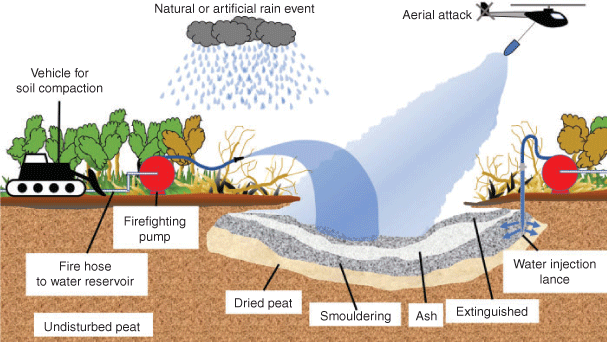
|
Owing to the subsurface nature of smouldering fires, it is much harder to detect and to access underground hotspots. As a result, an intuitive suppression approach may prove effective by directly channelling water into the subsurface hotspot with a water injection lance (Fig. 1). This method allows a targeted attack of smouldering hotspots. The efficiency of this method was investigated in the laboratory for smouldering coal fires (Hadden and Rein 2011) and in smouldering peat field experiments (Santoso 2020), showing lower efficiency (more water required) than spray methods.
Reflooding peatlands by temporally diverting water streams or a municipal supply is generally effective by increasing the moisture content (MC) of the peat above the critical MC of smouldering (Frandsen 1997; Huang et al. 2015), thus preventing future ignition and fire spread. Even though flooding requires large volumes of water, up to billions of litres of water, it has been shown to effectively suppress peat fires. Two examples are the 2008 Evans Road Fire in North Carolina, USA, and the 2018 Lake Cobrico Peat Fire in Victoria, Australia. In the 2008 Evans Road Fire, up to ~7.5 billion L of water was pumped from nearby lakes to reflood the peatland (Gabbert 2008; North Carolina Division of Air Quality 2009; US Fish and Wildlife Service 2009). This fire was declared to be extinguished 7 months after the fire was started by a lightning strike (Mickler et al. 2017). In the 2018 Lake Cobrico peat fire, a 4-km pipeline connected to the nearest municipal water connection was laid, supplying ~65 million L of water that enabled flooding of the fire perimeter (Pumps Journalist 2018). This fire was extinguished after 2 months (Neal 2018).
Beside firebreak flooding, fire breaks by fuel removal can also be considered in controlling peatland fire spread. However, this effort may not be effective if the peatland watertable is very low (Usup et al. 2004; Bourgault et al. 2019) since the peat layer can be very deep and the trench would need to be more than 5 m deep (Page et al. 2011), rendering this effort a tedious task.
The subsurface spread of peatland fires is possible and is fed by oxygen diffusion deep below the ground owing to the porosity of peat (Rein 2016). Removal of the oxygen supply by compacting the soil has been suggested as an effective firefighting method, according to an investigation conducted during the 2009 smouldering peat fire in Las Tablas de Daimiel National Park, Spain (Moreno et al. 2011). However, this method requires heavy machinery and access for such vehicles may be unavailable to peatlands owing to their geographic location. In summary, compared with soil compaction and fuel removal, cooling methods are the most feasible for suppressing peatland fires, including water spray, aerial attack, perimeter area reflooding and injection methods. The question is how much water is required for successful suppression.
Suppressant agents to fight wildfires
Suppression efficiency varies with the suppressant agents. The most utilised suppressants are water, firefighting foam, or mix of water and other suppressants (Plucinski 2019). Sand can also be considered as a suppressant because it is inert and highly dense but is more difficult to transport. In field conditions, the suppressant agent can be applied through the use of handheld firefighting equipment, fire trucks or aerial fleets (Plucinski 2019). In using firefighting agents, environmental safety is an important criterion. The development of environmentally friendly firefighting foams and agents and their effectiveness on both building and wildland fires have been investigated by several authors (Kennedy et al. 2015; Hinnant et al. 2017; Rakowska et al. 2017; Hinnant et al. 2020; Rivai et al. 2020; Subekti et al. 2020).
Foam suppression acts by smothering the smouldering, covering the surface of the fuel with a foam layer that prevents oxygen from accessing the fuel. In addition to its smothering effect, the foam layer also cools the surface of the fuel owing to the water content of the foam solution. Ratnasari et al. (2018) and Subekti et al. (2020) investigated the suppression time of peat fires using Class A fluorine-based foam and palm oil fatty acid-based foaming agent (FAP) foam respectively. Suppression time decreased with foam layer height while FAP foam performed more poorly than fluorine-based foam. In another report, Rivai et al. (2020) reported suppression times from applying various foam formulations derived from palm oil on 10-cm-deep smouldering peat. Foam stability can be an issue because the foam will be drained during the suppression effort (Kruglyakov et al. 2008). Since foam suppression relies on depriving smouldering of oxygen, once the foam is drained, it is no longer effective. This implies another difficult aspect of suppressing peat fires with foam since the required smothering holding time for smouldering can be days, weeks or months. This is in contrast to flaming wildfires, which may need hours (Rein 2016) and flaming liquid fires, which may only need minutes (Hinnant et al. 2020).
The use of fluorine-based foam to suppress wildfires is currently controversial owing to the environmental issues of per- and polyfluoroalkyl substances (PFAS), which are the main component of current commercial aqueous film-forming foam (AFFF) (Giesy and Kannan 2001; OECD 2013; USEPA 2014; Ruan and Jiang 2017). There is also an indication that long-chain PFASs, such as perfluorooctanoic acid (PFOA), can increase hydrophobicity (de Voogt et al. 2012), which by itself is a problem after peat fires (Perdana et al. 2018). If peat becomes hydrophobic after suppression with fluorine-based foam, restoration efforts by rewetting may become ineffective, leaving the peatland vulnerable to fires again in the next drought. Owing to the environmental issue of fluorine, alternative fluorine-free surfactants have been developed, including hydrocarbon-based foam (Hinnant et al. 2020), FAP (Subekti et al. 2020) and fluorine-free wetting agent (Rakowska et al. 2017).
Smouldering peat fire suppression by means of water has been investigated by Ramadhan et al. (2017) in 10-cm-deep peat and Lin et al. (2020) in 15-cm-deep peat. Ramadhan et al. (2017) reported a suppression time of ~65 min with ~12 L h−1 of water spray, while Lin et al. (2020) investigated water spray suppression at variable flow rates represented in rainfall rate unit (mm h−1). The critical rainfall rate required to suppress peat fires reported by Lin et al. (2020) was 4 mm h−1 for at least 5 h.
Wetting agents are substances that can reduce the surface tension of solid particles in a solid–liquid type suspension (Hao 2005). In contrast to foam that stays on the surface of the fuel, wetting agent can penetrate deep into the fuel. Owing to their lower liquid surface tension, wetting agent solutions penetrate up to 68 times faster than water through forest ground surface fuel (Rakowska et al. 2017). Peat fires can propagate in the shallow and deep layer of peat, leading to subsurface spread. Thus, surfactant ability to access the shallow layer and quickly reach the deeper peat layer is an important property for suppression efficiency. The effectiveness of foam on peat fire suppression has been investigated before, but no study has been conducted on the effectiveness of wetting agents on peat fires. In the present study, we aim to fill this gap by performing laboratory-scale experiments of peat fire suppression with both variable flow rate and environmentally friendly (fluorine-free) wetting agents. Upscaling calculation from lab-scale results in this study to field condition is also presented to assess the effect of wetting agent to the required amount of suppressant needed to suppress peat fire.
Material and methods
Our sample preparation protocol followed that in previous studies (Christensen et al. 2019; Hu et al. 2019). A commercially available peat was used (Shamrock Irish Moss Peat, Bord na Mona Horticulture Ltd) owing to its homogeneous properties and batch consistency in the long term. The elemental content of the peat on a dry mass basis was C/H/N/S of 54.1/5.1/1.3/0.5%, and the inorganic content (IC) was 2.5 ± 0.6% (Christensen et al. 2020). In this experiment, the MC of peat is ~100% (mass of water content over mass of dried peat). This MC is below the critical value for ignition of boreal peat when IC < 10% (Frandsen 1997; Huang et al. 2015) and represents drought peatlands (Usup et al. 2004). Samples were prepared by oven-drying peat at 80°C before adding water. The sample was mixed to ensure homogenisation and stored inside a sealed container for 24 h. Prior to the start of experiment, the sample was mixed well again. A subsample of 100 g was placed in an oven at 90°C for 7 h to measure the final MC (Christensen et al. 2019). The MC obtained in these experiments was 103.0 ± 6.8%, which corresponds to 204.4 ± 8.9 kg m−3 wet bulk density. A total of 19 kg of dry peat was used in the 49 experiments in this study.
An open-top reactor with internal dimensions of 20 × 20 × 10 cm was used (Huang et al. 2016) in which conditioned peat was deposited up to the rim. The reactor was built using ceramic insulation boards with thermal conductivity (k) = 0.7 W m−1 K−1, density (ρ) = 310 kg m−3 and specific heat capacity (cp) = 1090 J kg−1 K−1. The ignition protocol consisted of supplying 100 W for 30 min through an 18-cm coil heater mounted on one side of the reactor, which was 5 cm below the free surface. This ignition protocol can initiate self-sustained smouldering in peat with MC < 160% and IC < 10% (Hu et al. 2019). Fig. 2 shows the schematic of the experimental set-up. Measurements included in this experiment were mass loss (Mettler Toledo balance, resolution 0.01 g), visual and infrared (IR) imaging of the surface spread (GoPro Hero 5 and FLIR A655SC cameras) and temperature–time histories using thermocouples (12 K-type thermocouple (TC) array, 3 rows × 4 columns (see also Fig. 5 and Fig. S1 in supplementary material)). To avoid fluid build-up inside the reactor and to imitate suppression on deeper soils, holes were made at the bottom face of the reactor to allow fluid flow into a basin connected to container (Fig. 2). At the end of each experiment, the volume of fluid in this container was measured and is denoted runoff volume (Vo).
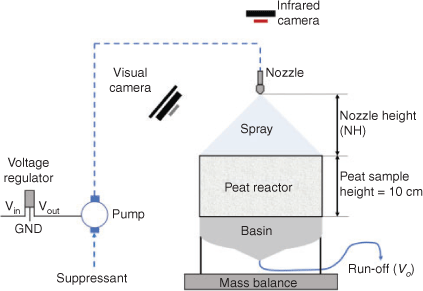
|
An infrared camera was used to determine the timing for initiation of suppression. This was when the smouldering front arrived at the centre of the reactor such that the front was directly below the spray nozzle. Since the infrared image only represents surface smouldering, the addition of mass loss measurements provides comprehensive monitoring to ensure the initiation of suppression was consistent across all experiments. Fig. 3 shows that the average mass fraction at the initiation of suppression, i.e. the arrival of the smouldering front at the centre of the reactor, is 59.6 ± 1.66%. This is equivalent to mass loss of 40.4%. The average time at the start of suppression (tsp) is 303.6 ± 49.3 min, across all 49 sets of conducted experiments. At the time that these two criteria were met, i.e. front below the nozzle and 40% mass loss, the temperatures of TC9 and TC10 were 400 to 550°C. This is discussed in the Results section. Smouldering was considered extinguished when all temperatures decreased below 50°C. This temperature criterion to identify extinguishment is a conservative value and has been used before in studies on smouldering coal (Hadden and Rein 2011). Once this was achieved, suppression was terminated and the suppression time was recorded.
Three different suppressant mixtures were studied: 0% (water only), 1% (low concentration (LC)), and 5% (high concentration (HC)) of fluorine-free wetting agent by weight in water. The wetting agent was ColdFire, produced by FireFreeze Worldwide, Inc. This wetting agent is a proprietary environmentally friendly formulation consisting of biodegradable anionic and non-ionic surfactants, organic compounds and minerals that have been tested to be free of PFAS (Firefreeze 2019). This wetting agent has liquid-to-air surface tension of 29.7 ± 2.36 mN m−1 (Rakowska et al. 2017), ~2.5 times lower than water’s, which is 72.02 mN m−1 (Nikitas and Pappa-Louisi 1990). The complete physicochemical properties of the wetting agent can be found in Rakowska et al. (2017).
Suppression flow rates ( ) were varied by adjusting both the height of the nozzle and the voltage supply to the pump (Fig. 2). Parameters controlling the flow rate were measured using an empty reactor on a mass balance. The flow rate was the rate of mass gained by the empty reactor. The flow rate decreased both with nozzle height and voltage (Fig. 4a). The increase in voltage increased pump pressure, which increased both volumetric flow rate and spray angle. Despite the increase in the volumetric flow rate, the increase in spray angle decreased the amount of water entering the reactor because the spray was wider than the reactor top area. The nozzle height and pump voltage were set before each experiment to obtain the desired flow rate based on the results shown in Fig. 4a. Suppression flow rate values were confirmed by data analysis averaging mass gain rate of the reactor due to the suppression flow into the reactor, from the start of the suppression to ~50 to 60% of the suppression time. Fig. 4b shows an example of mass gain rate from the start of suppression over the next 29 min, which is ~60% of the suppression time, in which the average of this mass gain rate corresponds to a suppression flow rate of 3.96 ± 0.47 L h−1. During this early stage of suppression, the peat was still smouldering. Because the mass loss from smouldering was negligibly small compared with the mass gain from suppression (~2 orders smaller than mass gain) and the decreasing burning rate due to smouldering being suppressed, mass loss from smouldering at this stage of suppression can be neglected. The rate of suppressant evaporation can also be assumed to be negligibly small, of the same order of sample mass loss due to smouldering.
) were varied by adjusting both the height of the nozzle and the voltage supply to the pump (Fig. 2). Parameters controlling the flow rate were measured using an empty reactor on a mass balance. The flow rate was the rate of mass gained by the empty reactor. The flow rate decreased both with nozzle height and voltage (Fig. 4a). The increase in voltage increased pump pressure, which increased both volumetric flow rate and spray angle. Despite the increase in the volumetric flow rate, the increase in spray angle decreased the amount of water entering the reactor because the spray was wider than the reactor top area. The nozzle height and pump voltage were set before each experiment to obtain the desired flow rate based on the results shown in Fig. 4a. Suppression flow rate values were confirmed by data analysis averaging mass gain rate of the reactor due to the suppression flow into the reactor, from the start of the suppression to ~50 to 60% of the suppression time. Fig. 4b shows an example of mass gain rate from the start of suppression over the next 29 min, which is ~60% of the suppression time, in which the average of this mass gain rate corresponds to a suppression flow rate of 3.96 ± 0.47 L h−1. During this early stage of suppression, the peat was still smouldering. Because the mass loss from smouldering was negligibly small compared with the mass gain from suppression (~2 orders smaller than mass gain) and the decreasing burning rate due to smouldering being suppressed, mass loss from smouldering at this stage of suppression can be neglected. The rate of suppressant evaporation can also be assumed to be negligibly small, of the same order of sample mass loss due to smouldering.
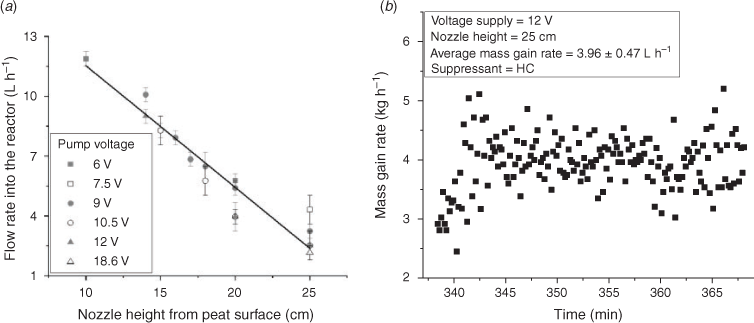
|
Results of smouldering spread
Temperature profiles
Before suppression was initiated, horizontal spread was faster 8 cm below the surface, leaving a layer of peat on top, as evidenced by the low temperatures measured by the top thermocouples in Fig. 5. This unburnt surface layer stayed intact for some time, forming an overhang, which collapsed later. This has been observed previously by Huang et al. (2016).
Fig. 5 shows temperature profiles without suppression as a baseline behaviour for comparison (red lines) and average temperature profiles from 21 experiments with water suppression (black lines) in which flow rate was varied between 3.6 and 16.6 L h−1. The ignition procedure is evidenced by the sharp increase in temperature measured by TC5 and TC9, also followed by a sharp decrease when the ignition procedure was stopped. Smouldering started at 5 cm depth from the top surface. From this point, i.e. TC5, smouldering then spread at a depth of ~8 cm, indicated by the trend of temperature increase from TC5 → TC9 → TC10 → TC11 → TC12 (red lines in Fig. 5).
In experiments with water suppression (black lines in Fig. 5), only the measured temperature of TC9 and TC10 was ~400°C at the start of the suppression, which is marked by the left side of the rectangular blue shading in Fig. 5. Thus, at the start of suppression, the smouldering front was around TC9 and TC10 (up to 7 cm away from the ignition wall). Fig. 5 shows that smouldering propagation at this time was also well beyond the steady state, which can also be seen in the mass data in Fig. 3b (see also Fig. S2). A small bump of temperature increase at TC11 in experiments with suppression indicates that the leading edge of the drying front was probably located between TC10 and TC11, ~9 cm away from the ignition wall. As can be seen in Fig. 5, smouldering spread beyond TC10 was successfully prevented after water suppression across all 21 experiments.
The dynamics of smouldering fires can be studied by the temperatures reached and the thermal residence time (Hartford and Frandsen 1992; Certini 2005; Rein et al. 2008). Thermal residence time is the amount of time that a point in the sample is above a certain temperature threshold, e.g. 60 min of thermal residence time for 100°C means that a point in the sample was at 100°C or above for 60 min (Rein et al. 2008). The thermal residence time of TC10 in Fig. 6 shows that suppression decreases thermal residence time across the temperature range from 100 to 650°C compared with cases without suppression. It can be seen that compared with the effect of suppressant concentration, flow rate has a stronger effect on decreasing residence time. By increasing the flow rate from 0.6 to 7.6 L h−1, thermal residence time decreases by ~1 h from 100 to 550°C (Fig. 6a). Considering the effect of the suppressant concentration, it can be seen that the LC affects thermal residence time almost in the same way as water, but further decreases residence time by 0.5 h only at temperatures above 300°C (Fig. 6b). HC has a stronger effect than LC in that the residence time decreases by ~0.5 h across all temperatures in comparison with water. In Fig. 6a, the standard deviations of LC thermal residence time are 0.6 h at low flow rate, 0.2 h at intermediate flow rate, and 0.12 h at high flow rate, whereas in Fig. 6b, the standard deviations of thermal residence time are 0.35 h for water, 0.2 h for LC and 0.03 h for HC.
Persistent smouldering
Fig. 7 shows a side-view schematic of the smouldering propagation based on temperatures in Fig. 5 and visual observation of the experiments (Fig. S2) and illustrating the location of TC10 close to the smouldering leading edge at the initiation of suppression. In Ramadhan et al. (2017), a temperature threshold of 80°C anywhere in the sample was the suppression criterion. However, in the present study, 14 experiments out of 49 show the occurrence of persistent smouldering, represented by a temperature increase and continuation of spread during suppression. During this persistent smouldering, the temperature at TC10 was seen to increase up to ~220°C (approximately peat smouldering temperature (Chen et al. 2011)) and this increase occurred after this temperature had decreased to as low as ~66°C (Fig. 8a). In other cases, smouldering continuously spread despite ongoing suppression as indicated by a temperature increase at TC11 (Fig. 8b). Both cases show a potential of reignition if suppression was stopped at a temperature above 50°C. In another study, Lin et al. (2020) reported a reignition of peat at a temperature of ~60°C. We choose 50°C as a conservative threshold for successful extinction since no reignition was observed when 50°C was the criterion. Successful suppression can also be identified from surface infrared radiation; however, IR was unable to detect the occurrence of persistent smouldering at depth (Fig. S3 and Fig. S4).
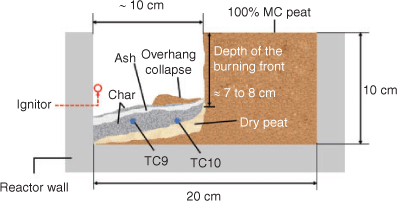
|
Temperature anomalies in Fig. 8a can also be caused by the thermocouple tip being surrounded by the solution for a while, thus causing a temperature decrease, followed by a temperature increase once the enveloping solution has dried. Another possible cause for the increase in temperature is the collapse of an overhang that burned near a thermocouple (Fig. 7), causing a perturbation in the temperature curve, which is thus not as smooth as if there was no collapse. Fig. 9 shows a summary of the occurrences of persistent smouldering (temperature increase at TC10 and continuation of spread to TC11) during ongoing suppression, showing a clear indication that these occurrences are less frequent with increasing flow rate and wetting agent concentration, with flow rate having the greater effect. Uncertainty can be caused by the TC being enveloped by the solution and overhang collapse.
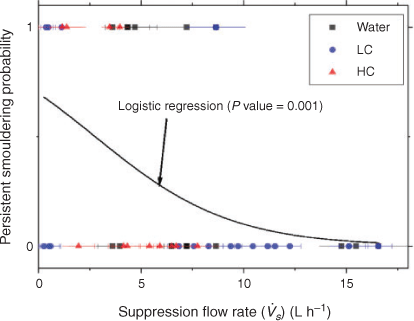
|
Results on suppression dynamics
Suppression time
As seen in Fig. 10, suppression time decreased with flow rate for all suppressant concentrations. The best-fit lines in Fig. 10 can be assumed to be a critical limit of suppression flow rate and time below which suppression is unsuccessful. In the range from 5 to 9 L h−1, the average suppression time with LC was 39% lower than with water, while with HC, the suppression time was 26% lower than with water. Even though LC on average was faster than HC, the standard deviation of LC time was ~20 min, significantly greater than the 6-min standard deviation for HC. This means HC is more reliable in reducing suppression time than LC. For example, our data shows that a suppression time of ~70 min can be achieved by HC with a flow rate of 1.5 L h−1 or a flow of 4.1 L h−1 with water. With high flow rates (9 to 18 L h−1), LC suppressant and water resulted in similar suppression times (<40 min). However, to achieve ~60 min suppression time, HC suppressant required a lower flow rate compared with water, resulting in 63% lower pump power (pump power is proportional to flow rate (Gerhart et al. 2016)), which is a crucial consideration for field conditions where remote locations make power supply challenging. The range and trend of suppression time reported here agree with previous studies for water (Ramadhan et al. 2017; Lin et al. 2020), while the present study includes wetting agents. Longer suppression times in Ramadhan et al. (2017) can be due to the much lower MC in their samples, i.e. 15%. With Netherlands peat samples at 50% MC, Lin et al. (2020) reported that 0.16 L h−1 water spray was the minimum flow rate for successful suppression, thus in agreement with the present study (Fig. 10).
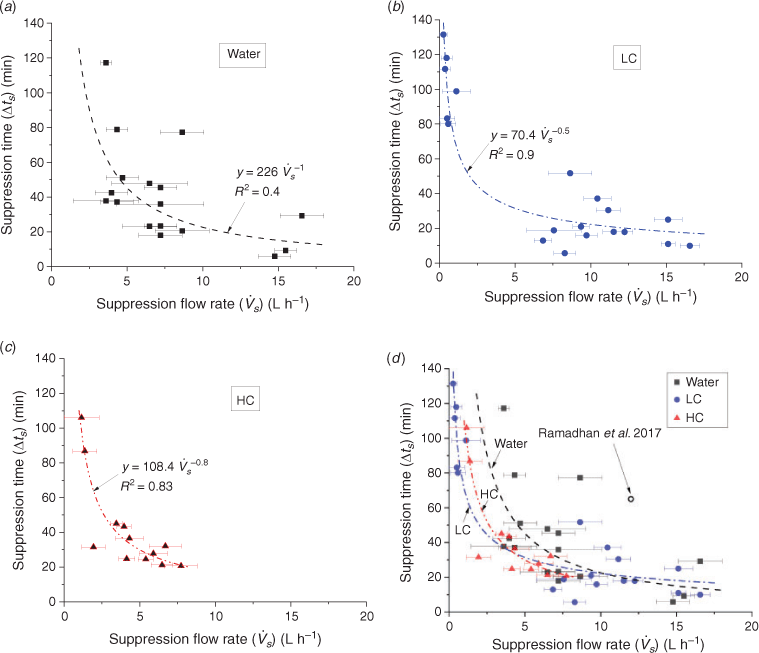
|
Suppression column height and runoff
Fig. 11a shows the ratio of runoff (Vo) volume to the total suppressant volume (Vt) of the three fluids (water, LC and HC). Runoff can be caused by uniform penetration of the suppressant or by channel formation. Uniform penetration is aided by the low surface tension enabling the suppressant to seep through the pores between soil particles. In this study, the wetting agent surface tension is ~2.5 times smaller than water surface tension. Higher runoff due to uniform penetration can aid suppression of deeper hotspots. For runoff due to channel formation, most of the suppressant flows through the same path, causing poor heat transfer and a smaller contact surface between the suppressant and the particle (Hadden and Rein 2011), thus decreasing suppression performance. Channels are formed when the surface tension of the suppressant is high and the suppressant encounters more resistance to seeping through the pores.
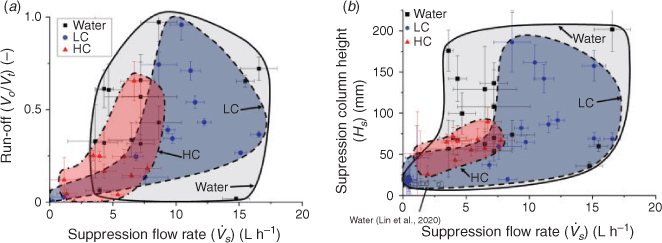
|
Fig. 11a shows runoff data for water, which are widely scattered, demonstrating no clear trend, and generally higher than wetting agent suppressants (both LC and HC) at flow rates below ~7 L h−1. Comparing runoff data in Fig. 11a with suppression time in Fig. 10d especially at flow rate below ~7 L h−1, the higher runoff of water than wetting agent suppressants is not accompanied by a shorter suppression time. This means that at low flow rates, water travels through the sample more quickly than wetting agent suppressants because of channelling, thus the longer suppression time. With wetting agent suppressants, runoff increases with flow rate. Comparing Fig. 11a with Fig. 10d, we see that the increase of runoff in wetting agent is accompanied by a significant decrease of suppression time. As the flow rate increases beyond ~7 L h−1, the runoff of wetting agent increases to the level of water, resulting in a shorter suppression time than water. This means that runoff in wetting agent is mainly caused by uniform penetration and that higher runoff is equivalent to better wetting over the whole sample.
Suppression column height or suppressant fluid volume per unit area can be calculated by using Eqn 1 where Hs is the suppression column height,  is the flow rate, Δts is the suppression time, and Ar is the reactor area (0.2 × 0.2 m). By looking at the lower suppression column height and shorter suppression time (at flow rates below 7 L h−1) of LC and HC compared with water (Fig. 10d and Fig. 11b), it can be seen that wetting agents increase suppression efficiency. Comparing Fig. 10d and Fig. 11b, the decrease of suppression time with flow rate is followed by increasing suppression column height, which can have a positive effect on suppression performance if the runoff is caused by uniform solution penetration.
is the flow rate, Δts is the suppression time, and Ar is the reactor area (0.2 × 0.2 m). By looking at the lower suppression column height and shorter suppression time (at flow rates below 7 L h−1) of LC and HC compared with water (Fig. 10d and Fig. 11b), it can be seen that wetting agents increase suppression efficiency. Comparing Fig. 10d and Fig. 11b, the decrease of suppression time with flow rate is followed by increasing suppression column height, which can have a positive effect on suppression performance if the runoff is caused by uniform solution penetration.

Fluid volume per mass of peat
The required volume of fluid to successfully suppress smouldering in 1 kg of peat (Vsp/msp) is calculated using Eqn 2 where Vsp is the total fluid volume, including the volume of suppressant applied ( ) and the moisture content left when suppression was initiated (Vw,sp) but excluding runoff (Vo); and msp is the mass of the dry peat and residue (char and ash) when suppression was initiated, i.e. 299.3 ± 18.5 g (equivalent to 40.4 ± 1.66% mass loss). msp was calculated by estimating the water content at the start of the suppression (mw,sp). By observing the average location of the front at suppression (Lsp), i.e. 10.9 ± 0.7 cm (Fig. 3a), the volume fraction of the unburnt sample (Xsp) can be estimated to be 0.46 ± 0.04 (Eqn 3, where Lr is the length of the reactor, which is 20 cm). Multiplying this volume fraction by the initial water content of the peat sample before ignition
) and the moisture content left when suppression was initiated (Vw,sp) but excluding runoff (Vo); and msp is the mass of the dry peat and residue (char and ash) when suppression was initiated, i.e. 299.3 ± 18.5 g (equivalent to 40.4 ± 1.66% mass loss). msp was calculated by estimating the water content at the start of the suppression (mw,sp). By observing the average location of the front at suppression (Lsp), i.e. 10.9 ± 0.7 cm (Fig. 3a), the volume fraction of the unburnt sample (Xsp) can be estimated to be 0.46 ± 0.04 (Eqn 3, where Lr is the length of the reactor, which is 20 cm). Multiplying this volume fraction by the initial water content of the peat sample before ignition  results in mw,sp (Eqn 4, where mb is the bulk mass of the sample before ignition). msp was obtained by subtracting mw,sp from the bulk mass data at the start of the suppression. The volume of water at the start of the suppression (Vw,sp) is obtained from the mass of the water (mw,sp) and ρw = 1 kg L−1 (in Eqn 2). Runoff is excluded in this calculation because it escapes the sample and therefore is not absorbed.
results in mw,sp (Eqn 4, where mb is the bulk mass of the sample before ignition). msp was obtained by subtracting mw,sp from the bulk mass data at the start of the suppression. The volume of water at the start of the suppression (Vw,sp) is obtained from the mass of the water (mw,sp) and ρw = 1 kg L−1 (in Eqn 2). Runoff is excluded in this calculation because it escapes the sample and therefore is not absorbed.



This total fluid volume per mass of peat is quite constant despite the wide range of flow rates and suppressant fluids. In other words, with increasing flow rate, runoff increases, and the volume of suppressant that is actively suppressing the fire is 5.7 ± 2.1 L kg−1 peat. This value can be understood as a critical flooding point, demonstrating the amount of water required to flood peat fires for successful suppression. Fig. 12 reports the critical flooding point in term of MC percentage (conversion of Vsp/msp by multiplying it by ρw and 100% where wetting agent density (ρsp) is the same as ρw = 1 kg L−1 (Rakowska et al. 2017)), showing a value of 572.9 ± 207.8% MC is required to suppress the peat fire. This is almost twice the typical value of peatland in flooded pristine conditions, i.e. ~300% MC (Moreno et al. 2011; Turetsky et al. 2015).
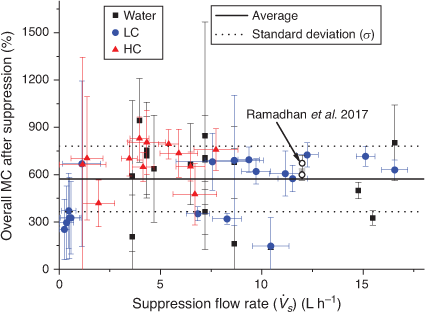
|
This critical value suggests that the suppression time is the duration needed to flood the peat. In other words, suppression time is the time needed for the suppressant at a specified flow rate and concentration to flood the peat to that critical flooding point. This value is affected to a certain degree by runoff as well, since higher runoff corresponds to a longer necessary time to flood the peat. This means suppression is a thermofluids phenomenon in absorbing media, and that the suppressant acts thermally and not chemically. Thus, the effect of both suppressant concentration and flow rate is to accelerate fluid transport through porous media over the depth of the sample. The low surface tension of the wetting agent probably helps avoid channel formation. This critical flooding point could be a soil property and the value found here is valid for the peat type used in this study. Compared with the literature, this critical value generally agrees in order of magnitude with the value reported by Ramadhan et al. (2017), i.e. ~6.4 L kg−1 peat. The slightly different average to Ramadhan et al. (2017) might be explained by the fact that the reported value in that study was based on the mass of the peat before ignition, whereas the value reported in the present study is based on the mass of the peat and residue before suppression started.
Even though higher runoff can indicate deeper suppressant penetration, the formation of channels, especially for water, is a concern because of less fluid participating in suppression. The constant critical flooding point confirms the two possible runoff mechanisms, i.e. channelling and uniform penetration. At low flow rate, the low runoff of LC and HC caused by uniform penetration resulted in shorter suppression times than water owing to faster flooding of the peat by LC and HC (Fig. 11a and Fig. 10d), whereas in case of water, the higher runoff at low flow rate is accompanied by a longer suppression time than LC and HC because the runoff was mainly caused by channel formation, causing most of the water to not contribute to peat flooding.
Upscaling to field conditions
Peat fire field experiments
In 2018, our group conducted field-scale experiments in Indonesia during which we ignited four peat fires, which burned for 4 to 10 days (Santoso 2020). Two rain events occurred during this time but the fires continued. The rainfall heights, equivalent to the suppression column height shown in Eqn 1, were 2.5 ± 0.1 and 4.8 ± 0.2 mm (Table 1). These values agree with our data because less than 36 ± 5 mm of water suppression would not suppress a peat fire. After 10 days, the four peat fires were suppressed in a controlled manner by means of water spray. The suppression times ranged from 17 to 42 min, and flow rates from 3000 to 4900 L h−1, resulting in column heights from 26.5 to 36.7 mm. This range of suppression times agrees well with our laboratory measurements even though the flow rates were far higher. The two rainfall events correspond to 1.9 to 2.6 L h−1 for 50 min and 1.3 to 8.8 L h−1 for 17 min, and both fall below the critical suppression limit in Fig. 10a, thus too quick for successful suppression. Lin et al. (2020) reported that the minimum column rate to suppress peat fires is 4 mm h−1, which is less than rain events recorded in our field experiments, i.e. 5.6 and 8.3 mm h−1. However, the minimum column rate should last for more than 5 h in order to successfully suppress peat fires (Lin et al. 2020), which is much longer than typical rainfall.
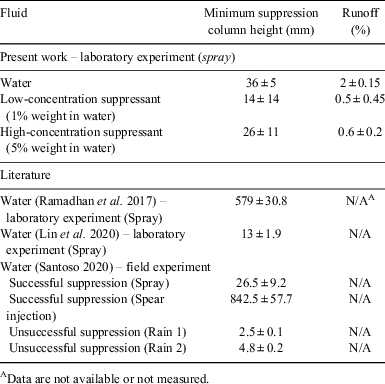
|
Table 1 shows a summary of suppression column height and runoff data for all currently available literature on peat fire suppression. It can be seen that the minimum suppression column height ranges from 13 to 36 mm, except for the two extremely high column height values from Ramadhan et al. (2017) of 579 ± 30.8 mm and from spear injection in GAMBUT (Santoso 2020) of 842.5 ± 57.7 mm.
Upscaling of laboratory results
Upscaling from laboratory data to the field can give an idea of the challenges of peat fire suppression in terms of flow rate and suppression time. Based on our data, we estimate the amount of suppressant fluid required to extinguish a hypothetical peat fire in the field with Eqn 5. It basically upscales the amount of required suppressant fluid from laboratory data ( ) to a hypothetical field scale through the ratio of the fire area in the field to fire area in the laboratory. This equation assumes a uniform flow rate over an extended area of the wildfire, thus can be used to approximate the required volume of suppressant fluid for a relatively small peat fire area.
) to a hypothetical field scale through the ratio of the fire area in the field to fire area in the laboratory. This equation assumes a uniform flow rate over an extended area of the wildfire, thus can be used to approximate the required volume of suppressant fluid for a relatively small peat fire area.

where Vs is the required volume of suppression agent (L) (which is ~5.7 ± 2.1 L kg−1 peat in Fig. 12),  is the suppression flow rate (L h−1), Δts is required suppression time (h), Af is fire area (m2), and Ar is the area of the reactor used in this study, i.e. 0.04 m2 (at the start of suppression, half of the peat [surface peat] in the reactor had already burnt).
is the suppression flow rate (L h−1), Δts is required suppression time (h), Af is fire area (m2), and Ar is the area of the reactor used in this study, i.e. 0.04 m2 (at the start of suppression, half of the peat [surface peat] in the reactor had already burnt).
For example, the average suppression time for water at a flow rate of 4 L h−1 in the laboratory reactor is ~63 min. Using Eqn 5, the amount of water required to extinguish, say, a 1-ha (1 × 104 m2) peat fire can be estimated to be of the order of 1 million L. If HC suppressant is used at the same flow rate, the average suppression time is 35 min, resulting in ~580 000 L of suppressant, approximately half the required volume with water.
Volumetric consideration can also be made in upscaling by including the depth of burn in Eqn 5, done by multiplying both fire area in the field and in the laboratory scale with their respective depth of burn. Taking the average depth of burn in peat fires from boreal and tropical regions, i.e. 39 cm (Santoso et al. 2019), and the laboratory-scale depth of burn in this study, i.e. ~8 cm, results in an ~5 fold increase of the amount of solution required to extinguish the hypothetical peat fire in the example above. This very high suppressant volume gives an idea of the difficulties of suppressing peat fires, as also reported from real peat fires incidents (Gabbert 2008; North Carolina Division of Air Quality 2009; Mickler et al. 2017; Pumps Journalist 2018).
Conclusions
We present suppression experiments on smouldering peat fires exploring the effect of three different concentrations of suppressant and variable flow rates. Suppression data are represented by suppression time, runoff ratio, column height, and fluid volume per mass of peat. Flow rates decrease suppression time for all solutions explored. Using wetting agent as a suppressant, a 26 to 39% decrease in suppression time can be achieved, with HC performing more reliably in reducing suppression time. The use of a wetting agent could decrease the required flow rate by 63%, thus also reducing the required pump power by the same order, and significantly decrease the required volume of suppressant agent. An upscaling demonstration of the results in this study to the field, an example case of a small peat fire, shows that a 50% decrease in the required suppressant volume per hectare of fire could be achieved with wetting agents as suppressant.
The decrease of suppression time with flow rate is at the expense of higher runoff. The runoff is caused by channelling in water or uniform penetration by wetting agent. The uniform penetration by wetting agent is because it has ~2.5 times lower surface tension than water. Runoff by uniform penetration is a positive factor in suppressing deep fires.
The actual volume of suppressant that actively extinguishes the fires was found to be quite constant across different flow rates and suppressant agents. We called this value the critical flooding point, which is 5.7 ± 2.1 L kg−1. This value being constant suggests that the wetting agent as suppressant acts thermally and not chemically.
We studied the occurrences of persistent smouldering despite ongoing suppression. The possibility of persistent smouldering decreased with increasing flow rate and suppressant concentration. The results presented here contribute to a better understanding on the mechanism of peat fires suppression, the role of flow rate and suppressant fluids, and the amount of resources needed to successfully stop peat wildfires.
Conflicts of interest
The authors declare no conflicts of interest.
Acknowledgements
The authors would like to thank the European Research Council (ERC) Consolidator Grant HAZE (682587) and the Doctoral Studies Scholarship funded by the Indonesia Endowment Fund for Education (LPDP) for research funding. We thank Hydro Navitas Solutions Ltd for providing Cold Fire wetting agent manufactured by Firefreeze Worldwide, Inc. We are grateful for fruitful discussions, assistance in the laboratory and proofreading from colleagues Dr Yuqi Hu, Matthew Bonner, Dwi M. J. Purnomo, Xuanze He and Simona Dossi at Imperial College London. We also thank Dr Yuqi Hu and Dwi M. J. Purnomo of Imperial College London, Dr Thomas Smith of the London School of Economics, Pither Palamba of Universitas Cenderawasih, and Harun Orion Purba and Yogi Wibowo Augusta of Universitas Riau for assistance in suppression during the 2018 GAMBUT field experiment in Indonesia.
References
Bourgault MA, Larocque M, Garneau M (2019) How do hydrogeological setting and meteorological conditions influence water table depth and fluctuations in ombrotrophic peatlands? Journal of Hydrology: X 4, 100032| How do hydrogeological setting and meteorological conditions influence water table depth and fluctuations in ombrotrophic peatlands?Crossref | GoogleScholarGoogle Scholar |
Certini G (2005) Effects of fire on properties of forest soils: a review. Oecologia 143, 1–10.
| Effects of fire on properties of forest soils: a review.Crossref | GoogleScholarGoogle Scholar | 15688212PubMed |
Chen H, Zhao W, Liu N (2011) Thermal analysis and decomposition kinetics of Chinese forest peat under nitrogen and air atmospheres. Energy & Fuels 25, 797–803.
| Thermal analysis and decomposition kinetics of Chinese forest peat under nitrogen and air atmospheres.Crossref | GoogleScholarGoogle Scholar |
Christensen E, Hu Y, Restuccia F, Santoso MA, Huang X, Rein G (2019) Experimental methods and scales in smouldering wildfires. In ‘Fire effects on soil properties’. (Eds P Pereira, J Mataix-Solera, X Ubeda, G Rein, A Cerdà) pp. 267–280. (CSIRO Publishing: Melbourne)
Christensen EG, Fernandez-Anez N, Rein G (2020) Influence of soil conditions on the multidimensional spread of smouldering combustion in shallow layers. Combustion and Flame 214, 361–370.
| Influence of soil conditions on the multidimensional spread of smouldering combustion in shallow layers.Crossref | GoogleScholarGoogle Scholar |
Davies GM, Gray A, Rein G, Legg CJ (2013) Peat consumption and carbon loss due to smouldering wildfire in a temperate peatland. Forest Ecology and Management 308, 169–177.
| Peat consumption and carbon loss due to smouldering wildfire in a temperate peatland.Crossref | GoogleScholarGoogle Scholar |
de Voogt P, Zurano L, Serné P, Haftka JJH (2012) Experimental hydrophobicity parameters of perfluorinated alkylated substances from reversed-phase high-performance liquid chromatography. Environmental Chemistry 9, 564–570.
| Experimental hydrophobicity parameters of perfluorinated alkylated substances from reversed-phase high-performance liquid chromatography.Crossref | GoogleScholarGoogle Scholar |
Firefreeze (2019) ColdFire: the next generation in firefighting. FireFreeze Worldwide, Inc. Available at https://firefreeze.com/wp-content/uploads/2019/03/Cold-Fire-Technical-Book.pdf [Verified 1 March 2021]
Frandsen W (1997) Ignition probability of organic soils. Canadian Journal of Forest Research 27, 1471–1477.
| Ignition probability of organic soils.Crossref | GoogleScholarGoogle Scholar |
Gabbert B (2008) NC: Evans Road fire update. Available at https://wildfiretoday.com/2008/06/17/nc-evans-road-fire-update/ [Verified 1 March 2021]
Gerhart PM, Gerhart AL, Hochstein JI (2016) ‘Munson, Young and Okiishi’s Fundamentals of fluid mechanics.’ (8th edn) (John Wiley & Sons, Inc.).
Gibbons P, van Bommel L, Gill AM, Cary GJ, Driscoll DA, Bradstock RA, Knight E, Moritz MA, Stephens SL, Lindenmayer DB (2012) Land management practices associated with house loss in wildfires. PLoS One 7, e29212
| Land management practices associated with house loss in wildfires.Crossref | GoogleScholarGoogle Scholar | 23227217PubMed |
Giesy JP, Kannan K (2001) Global distribution of perfluorooctane sulfonate in wildlife. Environmental Science & Technology 35, 1339–1342.
| Global distribution of perfluorooctane sulfonate in wildlife.Crossref | GoogleScholarGoogle Scholar |
Hadden R, Rein G (2011) Burning and water suppression of smoldering coal fires in small-scale laboratory experiments. In ‘Coal and peat fires: a global perspective. Volume 1: Coal – Geology and combustion’. (Eds GB Stracher, A Prakash, EV Sokol) pp. 317–326. (Elsevier B.V.)
Hao T (2005) Colloidal suspensions and electrorheological fluids. Studies in Interface Science 22, 1–17.
| Colloidal suspensions and electrorheological fluids.Crossref | GoogleScholarGoogle Scholar |
Hartford RA, Frandsen WH (1992) When it’s hot, it’s hot… Or maybe it’s not! (surface flaming may not portend extensive soil heating). International Journal of Wildland Fire 2, 139–144.
| When it’s hot, it’s hot… Or maybe it’s not! (surface flaming may not portend extensive soil heating).Crossref | GoogleScholarGoogle Scholar |
Hinnant KM, Giles SL, Ananth R (2017) Measuring fuel transport through fluorocarbon and fluorine-free firefighting foams. Fire Safety Journal 91, 653–661.
| Measuring fuel transport through fluorocarbon and fluorine-free firefighting foams.Crossref | GoogleScholarGoogle Scholar |
Hinnant KM, Giles SL, Smith EP, Snow AW, Ananth R (2020) Characterizing the role of fluorocarbon and hydrocarbon surfactants in firefighting-foam formulations for fire-suppression. Fire Technology 56, 1413–1441.
| Characterizing the role of fluorocarbon and hydrocarbon surfactants in firefighting-foam formulations for fire-suppression.Crossref | GoogleScholarGoogle Scholar |
Hu Y, Fernandez-Anez N, Smith TEL, Rein G (2018) Review of emissions from smouldering peat fires and their contribution to regional haze episodes. International Journal of Wildland Fire 27, 293–312.
| Review of emissions from smouldering peat fires and their contribution to regional haze episodes.Crossref | GoogleScholarGoogle Scholar |
Hu Y, Christensen EG, Amin HMF, Smith TEL, Rein G (2019) Experimental study of moisture content effects on the transient gas and particle emissions from peat fires. Combustion and Flame 209, 408–417.
| Experimental study of moisture content effects on the transient gas and particle emissions from peat fires.Crossref | GoogleScholarGoogle Scholar |
Huang X, Rein G, Chen H (2015) Computational smoldering combustion: Predicting the roles of moisture and inert contents in peat wildfires. Proceedings of the Combustion Institute 35, 2673–2681.
| Computational smoldering combustion: Predicting the roles of moisture and inert contents in peat wildfires.Crossref | GoogleScholarGoogle Scholar |
Huang X, Restuccia F, Gramola M, Rein G (2016) Experimental study of the formation and collapse of an overhang in the lateral spread of smouldering peat fires. Combustion and Flame 168, 393–402.
| Experimental study of the formation and collapse of an overhang in the lateral spread of smouldering peat fires.Crossref | GoogleScholarGoogle Scholar |
Huijnen V, Wooster MJ, Kaiser JW, Gaveau DLA, Flemming J, Parrington M, Inness A, Murdiyarso D, Main B, van Weele M (2016) Fire carbon emissions over maritime southeast Asia in 2015 largest since 1997. Scientific Reports 6, 26886
| Fire carbon emissions over maritime southeast Asia in 2015 largest since 1997.Crossref | GoogleScholarGoogle Scholar | 27241616PubMed |
Kennedy MJ, Conroy MW, Dougherty JA, Otto N, Williams BA, Ananth R, Fleming JW (2015) Bubble coarsening dynamics in fluorinated and non-fluorinated firefighting foams. Colloids and Surfaces. A, Physicochemical and Engineering Aspects 470, 268–279.
| Bubble coarsening dynamics in fluorinated and non-fluorinated firefighting foams.Crossref | GoogleScholarGoogle Scholar |
Kruglyakov PM, Karakashev SI, Nguyen AV, Vilkova NG (2008) Foam drainage. Current Opinion in Colloid & Interface Science 13, 163–170.
| Foam drainage.Crossref | GoogleScholarGoogle Scholar |
Lin S, Cheung YK, Xiao Y, Huang X (2020) Can rain suppress smoldering peat fire? The Science of the Total Environment 727, 138468
| Can rain suppress smoldering peat fire?Crossref | GoogleScholarGoogle Scholar | 32334212PubMed |
McCaffrey SM, Rhodes A (2009) Public Response to Wildfire: Is the Australian “Stay and Defend or Leave Early” Approach an Option for Wildfire Management in the United States? Journal of Forestry 107, 9–15.
| Public Response to Wildfire: Is the Australian “Stay and Defend or Leave Early” Approach an Option for Wildfire Management in the United States?Crossref | GoogleScholarGoogle Scholar |
Mickler RA, Welch DP, Bailey AD (2017) Carbon emissions during wildland fire on a North American temperate peatland. Fire Ecology 13, 34–57.
| Carbon emissions during wildland fire on a North American temperate peatland.Crossref | GoogleScholarGoogle Scholar |
Mikalsen RF, Hagen BC, Steen-Hansen A, Krause U, Frette V (2019) Extinguishing smoldering fires in wood pellets with water cooling: an experimental study. Fire Technology 55, 257–284.
| Extinguishing smoldering fires in wood pellets with water cooling: an experimental study.Crossref | GoogleScholarGoogle Scholar |
Moreno L, Jiménez ME, Aguilera H, Jiménez P, de la Losa A (2011) The 2009 smouldering peat fire in Las Tablas de Daimiel National Park (Spain). Fire Technology 47, 519–538.
| The 2009 smouldering peat fire in Las Tablas de Daimiel National Park (Spain).Crossref | GoogleScholarGoogle Scholar |
Neal M (2018) Peat fires burning in south-west Victoria since mid-March appear to be out. Available at https://www.abc.net.au/news/2018-05-07/peat-fires-south-west-victoria-appear-to-be-out/9734054 [Verified 1 March 2021]
Nikitas P, Pappa-Louisi A (1990) Thermodynamic and modelistic study of surface solution: aqueous solutions containing 2-butanol. The Journal of Physical Chemistry A 94, 361–370.
| Thermodynamic and modelistic study of surface solution: aqueous solutions containing 2-butanol.Crossref | GoogleScholarGoogle Scholar |
North Carolina Division of Air Quality (2009) NC Exceptional Event (June, 2008). Available at https://files.nc.gov/ncdeq/Air%20Quality/monitor/specialstudies/exceptionalevents/2008/Exceptional%20Event%20Evans%20Road%20Fire.pdf [Verified 1 March 2021]
Ohlemiller TJ (1985) Modeling of smoldering combustion propagation. Progress in Energy and Combustion Science 11, 277–310.
| Modeling of smoldering combustion propagation.Crossref | GoogleScholarGoogle Scholar |
Organisation for Economic Co‐operation and Development (OECD) (2013) Synthesis paper on per‐ and polyfluorinated chemicals (PFCs). Available at https://www.oecd.org/env/ehs/risk-management/PFC_FINAL-Web.pdf [Verified 1 March 2021]
Page SE, Siegert F, Rieley JO, Boehm HDV, Jaya A, Limin S (2002) The amount of carbon released from peat and forest fires in Indonesia during 1997. Nature 420, 61–65.
| The amount of carbon released from peat and forest fires in Indonesia during 1997.Crossref | GoogleScholarGoogle Scholar | 12422213PubMed |
Page SE, Rieley JO, Banks CJ (2011) Global and regional importance of the tropical peatland carbon pool. Global Change Biology 17, 798–818.
| Global and regional importance of the tropical peatland carbon pool.Crossref | GoogleScholarGoogle Scholar |
Perdana L, Ratnasari N, Ramadhan M, Palamba P, Nasruddin N, Nugroho Y (2018) Hydrophilic and hydrophobic characteristics of dry peat. IOP Conference Series. Earth and Environmental Science 105, 012083
| Hydrophilic and hydrophobic characteristics of dry peat.Crossref | GoogleScholarGoogle Scholar |
Plucinski MP (2019) Fighting flames and forging firelines: wildfire suppression effectiveness at the fire edge. Current Forestry Reports 5, 1–19.
| Fighting flames and forging firelines: wildfire suppression effectiveness at the fire edge.Crossref | GoogleScholarGoogle Scholar |
Pumps Journalist (2018) Fighting the Cobrico peat fire. Available at https://www.pumpindustry.com.au/fighting-the-cobrico-peat-fire [Verified 1 March 2021].
Rakowska J, Szczygieł R, Kwiatkowski M, Porycka B, Radwan K, Prochaska K (2017) Application tests of new wetting compositions for wildland firefighting. Fire Technology 53, 1379–1398.
| Application tests of new wetting compositions for wildland firefighting.Crossref | GoogleScholarGoogle Scholar |
Ramadhan ML, Palamba P, Imran FA, Kosasih EA, Nugroho YS (2017) Experimental study of the effect of water spray on the spread of smoldering in Indonesian peat fires. Fire Safety Journal 91, 671–679.
| Experimental study of the effect of water spray on the spread of smoldering in Indonesian peat fires.Crossref | GoogleScholarGoogle Scholar |
Ratnasari NG, Dianti A, Palamba P, Ramadhan ML, Prayogo G, Pamitran AS, Nugroho YS (2018) Laboratory scale experimental study of foam suppression on smouldering combustion of a tropical peat. Journal of Physics: Conference Series 1107, 052003
| Laboratory scale experimental study of foam suppression on smouldering combustion of a tropical peat.Crossref | GoogleScholarGoogle Scholar |
Rein G (2013) Smouldering fires and natural fuels. In ‘Fire phenomena and the Earth system’. (Ed. CM Belcher) pp. 15–33. (John Wiley & Sons, Inc.)
Rein G (2016) Smoldering combustion. In ‘SFPE Handbook of fire protection engineering’. (Eds MJ Hurley, D Gottuk, JR Hall, K Harada, E Kuligowski, M Puchovsky, J Torero, JM Watts, C Wieczorek) pp. 581–603. (Springer: New York)
Rein G, Cleaver N, Ashton C, Pironi P, Torero JL (2008) The severity of smouldering peat fires and damage to the forest soil. Catena 74, 304–309.
| The severity of smouldering peat fires and damage to the forest soil.Crossref | GoogleScholarGoogle Scholar |
Rivai M, Hambali E, Suryani A, Pramuhadi G, Subekti P (2020) Performance improvement of palm oil foaming agent concentrates as fire extinguishment materials in peatlands. IOP Conference Series. Earth and Environmental Science 460, 012026
| Performance improvement of palm oil foaming agent concentrates as fire extinguishment materials in peatlands.Crossref | GoogleScholarGoogle Scholar |
Ruan T, Jiang G (2017) Analytical methodology for identification of novel per- and polyfluoroalkyl substances in the environment. Trends in Analytical Chemistry 95, 122–131.
| Analytical methodology for identification of novel per- and polyfluoroalkyl substances in the environment.Crossref | GoogleScholarGoogle Scholar |
Santoso MA (2020) Experimental study of smouldering wildfires, suppression and transition to flaming. PhD thesis, Imperial College London, UK.
Santoso MA, Huang X, Prat-Guitart N, Christensen E, Hu Y, Rein G (2019) Smouldering fires and soils. In ‘Fire effects on soil properties’. (Eds P Pereira, J Mataix-Solera, X Ubeda, G Rein, A Cerdà) pp. 203–216. (CSIRO Publishing: Melbourne)
Shukla JB, Misra AK, Naresh R, Chandra P (2010) How artificial rain can be produced? A mathematical model. Non-linear Analysis Real World Applications 11, 2659–2668.
| How artificial rain can be produced? A mathematical model.Crossref | GoogleScholarGoogle Scholar |
Subekti P, Hambali E, Suryani A, Suryadarma P, Saharjo BH, Rivai M (2020) The effects of magnesium sulphate addition into foaming agents resulted from palm oil fatty acid saponification in the performance of peat fire suppression. IOP Conference Series. Earth and Environmental Science 460, 012028
| The effects of magnesium sulphate addition into foaming agents resulted from palm oil fatty acid saponification in the performance of peat fire suppression.Crossref | GoogleScholarGoogle Scholar |
Sutikno S, Amalia IR, Sandhyavitri A, Syahza A, Widodo H, Seto TH (2020) Application of weather modification technology for peatlands fires mitigation in Riau, Indonesia. AIP Conference Proceedings 2227, 030007
| Application of weather modification technology for peatlands fires mitigation in Riau, Indonesia.Crossref | GoogleScholarGoogle Scholar |
Turetsky MR, Benscoter B, Page S, Rein G, van der Werf GR, Watts A (2015) Global vulnerability of peatlands to fire and carbon loss. Nature Geoscience 8, 11–14.
| Global vulnerability of peatlands to fire and carbon loss.Crossref | GoogleScholarGoogle Scholar |
US Environmental Protection Agency (USEPA) (2014) Emerging contaminants-perfluorooctane sulfonate (PFOS) and perflu-orooctanoic acid (PFOA). Emerging contaminants fact sheet–PFOS and PFOA. Available at https://nepis.epa.gov [Verified 1 March 2021]
US Fish and Wildlife Service (2009) Largest Refuge Fire of 2008 declared out. Available at https://www.fws.gov/fire/news/nc/evans_road.shtml [Verified 1 March 2021]
Usup A, Hashimoto Y, Takahashi H, Hayasaka H (2004) Combustion and thermal characteristic of peat fire in tropical peatland in Central Kalimantan, Indonesia. Tropics 14, 1–19.
| Combustion and thermal characteristic of peat fire in tropical peatland in Central Kalimantan, Indonesia.Crossref | GoogleScholarGoogle Scholar |
Walker XJ, Baltzer JL, Cumming SG, Day NJ, Ebert C, Goetz S, Johnstone JF, Potter S, Rogers BM, Schuur EAG, Turetsky MR, Mack MC (2019) Increasing wildfires threaten historic carbon sink of boreal forest soils. Nature 572, 520–523.
| Increasing wildfires threaten historic carbon sink of boreal forest soils.Crossref | GoogleScholarGoogle Scholar | 31435055PubMed |


